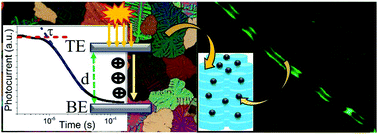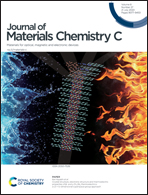Carbon dot-dispersed hexabutyloxytriphenylene discotic mesogens: structural, morphological and charge transport behavior†
Abstract
Triphenylene-core grafted 2,3,6,7,10,11-hexabutyloxytriphenylene (HAT4) discotic mesogens were synthesized and their composite matrices have been prepared by dispersing different concentrations of carbon dots (C-dots). The structural, morphological, and charge transport behaviors of the neat and composite matrices have been studied as a function of dopant concentration. The triphenylene matrix remains invariant after the controlled dispersion of quantum sized C-dots; nevertheless, the electronic and transport properties of the neat matrix have been changed significantly. The percolated network of C-dots in the HAT4 matrix offers 102 and 103 times higher conduction current in the columnar and crystalline phases, respectively; however, the charge carrier mobility is found to be reduced due to the surface-recombination and the change in the columnar ordering. In the Colhp phase, the HAT4/C-dots matrix exhibited maximum conductivity and charge mobility of the order of 10−6 S m−1 and 10−2 cm2 V−1 s−1, respectively. The superior behavior of the HAT4/C-dot composites, which could overcome the poor conductivity of organic semiconductors, indicates their potential for practical applications in organic semiconducting devices and optoelectronics.



 Please wait while we load your content...
Please wait while we load your content...